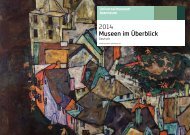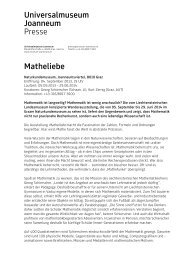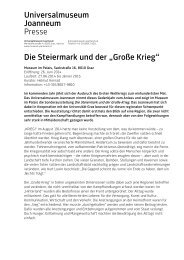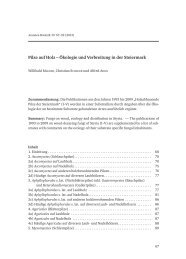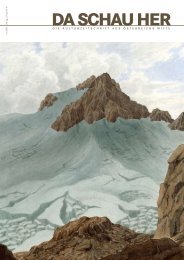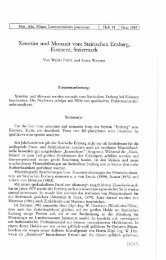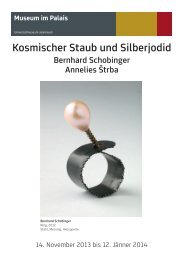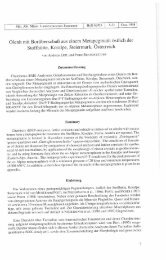Katalog/Catalogue - deutsch/englisch
Katalog/Catalogue - deutsch/englisch
Katalog/Catalogue - deutsch/englisch
Erfolgreiche ePaper selbst erstellen
Machen Sie aus Ihren PDF Publikationen ein blätterbares Flipbook mit unserer einzigartigen Google optimierten e-Paper Software.
die Dinge der Natur sich nicht wesentlich von der Menschheit<br />
unterscheiden und dass sie mit einem Geist beseelt sind, der<br />
dem des Menschen ähnlich ist.”3<br />
Die essentielle Ähnlichkeit von Mensch und Natur manifestiert<br />
sich sowohl im emotionalen Bereich wie auch auf der existentiellen<br />
Ebene. Beide Sphären sind stark von der Ästhetik geprägt<br />
und stellen Motive dar, die in der Kunst stets präsent sind. Bei<br />
Ersterer tritt die ästhetische Kategorie „mono-no-aware“ in<br />
den Vordergrund, die ihre Entsprechung in unserem Begriff<br />
„lacrimae rerum“ („Die Dinge haben ihre Tränen”) hat, womit<br />
eine spezifische Empfindlichkeit der Gegenstände gemeint ist.<br />
Dabei werden Dinge oder Situationen, die von einer besonderen<br />
Gefühlsstimmung umgeben sind, durch das Mitfühlen erfahren,<br />
das dank der Ähnlichkeit der menschlichen Gefühle und der<br />
emotionalen Aura der Natur möglich ist. Da „mono-no-aware“<br />
eng verknüpft ist mit dem Nachdenken über die Unbeständigkeit<br />
und Flüchtigkeit sowohl der Erscheinungen der Natur als auch<br />
der menschlichen Existenz, ist es meistens, wenn auch nicht<br />
immer, gleichbedeutend mit einer wehmütigen und melancholischen<br />
Stimmung. Die Stimmung, dass alles vergänglich ist, die<br />
durch den Buddhismus gefestigt wurde, durchdringt die japanische<br />
Kunst und Ästhetik und bewirkt, dass die Erscheinungen<br />
nicht zur Zeit ihrer Fülle und Blütezeit, sondern während ihres<br />
Entstehens und Schwindens stark aufgewertet werden. Der<br />
Mönch Kenko, der im Mittelalter lebte, fragte in Tsurezuregusa<br />
(Essays über den Müßiggang): „Sollen wir die Kirschblüten nur<br />
betrachten, wenn sie in voller Blüte stehen, den Mond nur dann,<br />
wenn es wolkenlos ist?” Und er antwortete: „Zweige, die am<br />
Erblühen sind, oder Gärten, in denen verwelkte Blüten verstreut<br />
sind, verdienen eher unsere Bewunderung.“4<br />
Im gleichen Sinne äußert sich der zeitgenössische Maler<br />
Higashiyama Kaii: „Die Blumen schauen zum Mond hinauf. Der<br />
Mond schaut auf die Blumen... Das nennt man wohl eine Begegnung.<br />
Blumen stehen nur eine kurze Zeit in ihrer vollen<br />
Blüte und es ist sehr schwierig für sie, dem Mond zu begegnen.<br />
Zudem ist Vollmond nur diese eine Nacht. Falls es wolkig ist<br />
oder regnet, sehen wir ihn nicht. Außerdem muss ich da sein, um<br />
es zu beobachten... Wenn Blumen die ganze Zeit in voller Blüte<br />
ständen und wir für immer existierten, wären wir von dieser<br />
Begegnung nicht gerührt. Blüten stellen ihre Lebensglut zur<br />
Schau, indem sie zu Boden fallen.”5<br />
Was will uns Yoshihiro Suda mit seiner künstlichen Rose sagen,<br />
deren Blütenblätter „zu Boden fallen“? Dass von der Vergänglichkeit<br />
lebende wie tote Dinge betroffen sind? Vielleicht wollte<br />
er aber – wie das japanische Künstler seit Jahrhunderten,<br />
Krystyna Wilkoszewska 78 79<br />
mankind, and that they are endowed with spirits similar<br />
to those of men.”3<br />
The fundamental similarity between humans and nature<br />
manifests itself both in the emotional sphere and at the<br />
existential level. Both are strongly marked by the aesthetic<br />
and form motifs that are always present in art. In the case<br />
of the former, the aesthetic category “mono-no-aware”<br />
comes to the fore, corresponding to our concept of<br />
“lacrimae rerum” (“tears of things”), i.e. the singular sensitivity<br />
of objects. This concerns a special emotional mood<br />
that surrounds things or situations whose experience is<br />
based on empathy, made possible by the similarity of<br />
human emotion to the emotional aura of nature. For the<br />
most part, although not always, “mono-no-aware” denotes<br />
a mood of sadness and melancholy that results from<br />
rumination on the transience both of the phenomena of<br />
nature and of human existence. The idea of everything’s<br />
transience that is established in Buddhism permeates<br />
Japanese art and aesthetics, and gives rise to a higher<br />
estimation of phenomena during their rise and fall than<br />
at the time of their full bloom. Kenko, a monk in the<br />
Middle Ages, asked in Tsurezuregusa (Essays in Idleness):<br />
“Are we to look at cherry blossoms only in full bloom,<br />
the moon only when it is cloudless?” And answered:<br />
“Branches about to blossom or gardens strewn with faded<br />
flowers are worthier of our admiration.”4<br />
The painter Higashiyama Kaii, a contemporary, said in<br />
the same spirit: “Flowers look up at the moon. The moon<br />
looks at the flowers... This must be what is called an<br />
encounter. Flowers stay in their fullest bloom only for a<br />
short period of time and it is very difficult for them to<br />
encounter the moon. Moreover, the full moon is only for<br />
this one night. If cloudy or rainy, this view cannot be seen.<br />
Furthermore, I must be there to watch it...<br />
If flowers are in full bloom all the time and if we exist<br />
forever, we won’t be moved by this encounter. Flowers<br />
exhibit their glow of life by falling to the ground.”5<br />
What does Yoshihiro Suda want to tell us with his artificial<br />
rose, whose petals “fall on the ground”? That transience<br />
affects both things that are alive and lifeless? Or perhaps<br />
he wanted – as Japanese artists have done for centuries,<br />
starting with the tenth-century Murasaki Shikibu who<br />
wrote Genji monogatari, or Sei Shonagon, the author of<br />
Makura no soshi – to evoke in us the singular mood of<br />
sadness and melancholy “mono-no-aware”, in which the



